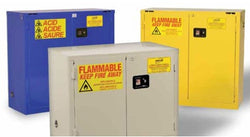Safety Cabinets
The Importance of Safety Cabinets in the Lab Environment
Safety cabinets are essential for any laboratory that handles volatile, flammable, or hazardous chemicals. They offer a secure storage solution to isolate dangerous materials, reduce the risk of spills or vapor release, and protect personnel. A properly rated flammable safety cabinet provides a controlled environment that slows the rate of temperature rise during a fire event, giving occupants and responders more time to act. By choosing certified safety cabinets, labs adhere to industry safety codes and regulatory requirements.
Jump to Our Safety Cabinets!
Compliance, Certification, and Standards
Not all storage cabinets are equal, and for handling flammable liquids or solvents, only cabinets certified to the correct standards should be used. Our safety cabinets are FM-approved and meet requirements from OSHA, NFPA, SEFA, and UFC. (These codes set guidelines for fire-resistance, construction, ventilation, spill capacity, and safety labeling.) Having a cabinet that satisfies these standards helps your facility stay compliant during audits or inspections, reduces liability, and ensures that the safety cabinets perform as intended under stress conditions.
Construction, Materials, and Design Features
When it comes to safety cabinets, robust construction is key. High-quality cabinets are built using heavy-gauge steel with welded seams and reinforced walls to prevent warping or degradation over time. Internal shelves must be spill-proof with raised lips to contain leaks or drips. Doors should feature self-closing mechanisms or positive-latch systems to ensure they remain shut in an emergency. Some flammable safety cabinet designs also include built-in vents or ports for connection to external safety exhaust systems, if your facility requires forced ventilation. Moreover, a proper degree of corrosion-resistant finish and chemical-resistant interiors ensures that the cabinet stands up to repeated exposure to solvents or aggressive reagents.
Capacity Sizing and Configuration Options
Each laboratory has unique space constraints and chemical inventories, so selecting the correct size and configuration is vital. Cabinets come in a variety of widths, heights, and depths, with options for single or double doors, adjustable shelving, fixed shelves, or compartments. Consider your typical storage volumes, footprint constraints, and ease of access to choose the right configuration. For example, if your lab stores small solvent bottles, you may want narrower shelf spacing and raised lips. For larger drums or bulk containers, a deeper cabinet with fewer shelves may suit better. The flexibility in design allows labs to optimize the use of space while maintaining safety.
Best Practices for Use and Placement
Installing safety cabinets in safe, strategic locations enhances their effectiveness. Place them on level floors, away from direct heat sources, and at least several inches off the ground to facilitate clean-up and inspection beneath. Do not block airflow vents or obstruct doors. Store only compatible chemicals in a given cabinet; never mix oxidizers with flammables, and segregate acids, bases, and solvents as required by safety protocols. Label each cabinet clearly, maintain an up-to-date inventory of contents, and periodically inspect for corrosion, damaged seals, or leaks. In the event of a spill, ensure absorbent materials and secondary containment trays are in place within the cabinet to catch runoff.
Maintenance, Inspection, and Training
Regular maintenance helps ensure long service life and safety. Inspect safety cabinets monthly (or per your institutional protocol) to check for damaged inner lips, worn door seals, clean drainage channels, and proper operation of self-closing doors. If the cabinet includes vent ports, confirm that caps and gaskets are intact and properly sealed. Keep documentation of inspections, repairs, and any test logs. Provide training to laboratory personnel on correct opening, closing, loading, and emergency procedures involving the cabinet. Emphasize that flammable safety cabinet use is only one element of a larger chemical safety program; proper handling, labeling, and disposal must accompany correct storage.
Advantages of Our Safety Cabinets
By choosing Blackland’s safety cabinets, you gain a combination of stringent certification, adaptable design, and consistent quality control. Our cabinets provide: full compliance with industry standards; sturdy steel construction and internal features that reduce the likelihood of leaks; flexible shelving options to match your inventory needs; comprehensive safety labeling; and reliable performance under challenging lab conditions. If you require customization in size or features, we can work with you to tailor a solution.

